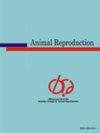In vitro embryo production in small ruminants: what is still missing?
IF 1.6
4区 农林科学
Q2 AGRICULTURE, DAIRY & ANIMAL SCIENCE
引用次数: 0
Abstract
In vitro embryo production (IVEP) is an extremely important tool for genetic improvement in livestock and it is the biotechnology that has grown the most recently. However, multiple ovulation followed by embryo transfer is still considered the leading biotechnology for embryo production in small ruminants. This review aimed to identify what is still missing for more efficient diffusion of IVEP in small ruminants, going through the IVEP steps and highlighting the main factors affecting the outcomes. Oocyte quality is essential for the success of IVEP and an aspect to be considered in small ruminants is their reproductive seasonality and strategies to mitigate the effect of season. The logistics for oocyte collection from live females is more complex than in cattle, and tools to simplify this collection system and/or to promote an alternative way of recovering oocytes may be an important point in this scenario. The heterogeneity of oocytes collected from growing follicles in live females or from ovaries collected from abattoirs remains a challenge, and there is a demand to standardize/homogenize the hormonal stimulatory protocols and IVM protocols for each source of oocytes. The use of sexed semen is technically possible, however the low market demand associated with the high costs of the sexing process prevents the routine use of this technique, but its higher availability is an important aspect aiming for greater dissemination of IVEP. New noninvasive approaches for embryo selection are key factors since the selection for transfer or cryopreservation is another difficulty faced among laboratories. Embryo selection is based on morphological traits, although these are not necessarily reliable in predicting pregnancy. Several issues described in this review must be considered by researchers in other to promote the diffusion of IVEP in small ruminants.小型反刍动物体外胚胎生产:还缺少什么?
体外胚胎生产(IVEP)是家畜遗传改良的一种极其重要的工具,也是最近发展起来的生物技术。然而,多次排卵后胚胎移植仍然被认为是小反刍动物胚胎生产的主要生物技术。本综述旨在确定在小型反刍动物中更有效地传播IVEP还缺少什么,通过IVEP步骤并强调影响结果的主要因素。卵母细胞质量是IVEP成功的关键,在小反刍动物中需要考虑的一个方面是它们的繁殖季节性和减轻季节影响的策略。从活雌卵母细胞中收集卵母细胞的后勤工作比从牛卵母细胞中收集卵母细胞要复杂得多,在这种情况下,简化这一收集系统和/或促进回收卵母细胞的替代方法的工具可能是重要的一点。从活的雌性生长卵泡或从屠宰场收集的卵巢中收集的卵母细胞的异质性仍然是一个挑战,并且需要对每种卵母细胞来源的激素刺激方案和IVM方案进行标准化/均质化。使用性别鉴定的精液在技术上是可能的,但是,由于市场需求低,加上性别鉴定过程费用高,妨碍了这种技术的常规使用,但其较高的可得性是旨在更广泛地传播试管婴儿方案的一个重要方面。新的无创胚胎选择方法是关键因素,因为选择移植或冷冻保存是实验室面临的另一个难题。胚胎选择是基于形态特征的,尽管这些特征在预测怀孕方面不一定可靠。为了促进IVEP在小反刍动物中的扩散,研究人员必须考虑本综述中描述的几个问题。
本文章由计算机程序翻译,如有差异,请以英文原文为准。
求助全文
约1分钟内获得全文
求助全文
来源期刊

Animal Reproduction
AGRICULTURE, DAIRY & ANIMAL SCIENCE-
CiteScore
2.30
自引率
11.80%
发文量
49
审稿时长
70 days
期刊介绍:
Animal Reproduction (AR) publishes original scientific papers and invited literature reviews, in the form of Basic Research, Biotechnology, Applied Research and Review Articles, with the goal of contributing to a better understanding of phenomena related to animal reproduction.
The scope of the journal applies to students, researchers and practitioners in the fields of veterinary, biology and animal science, also being of interest to practitioners of human medicine. Animal Reproduction Journal is the official organ of the Brazilian College of Animal Reproduction in Brazil.
 求助内容:
求助内容: 应助结果提醒方式:
应助结果提醒方式:


